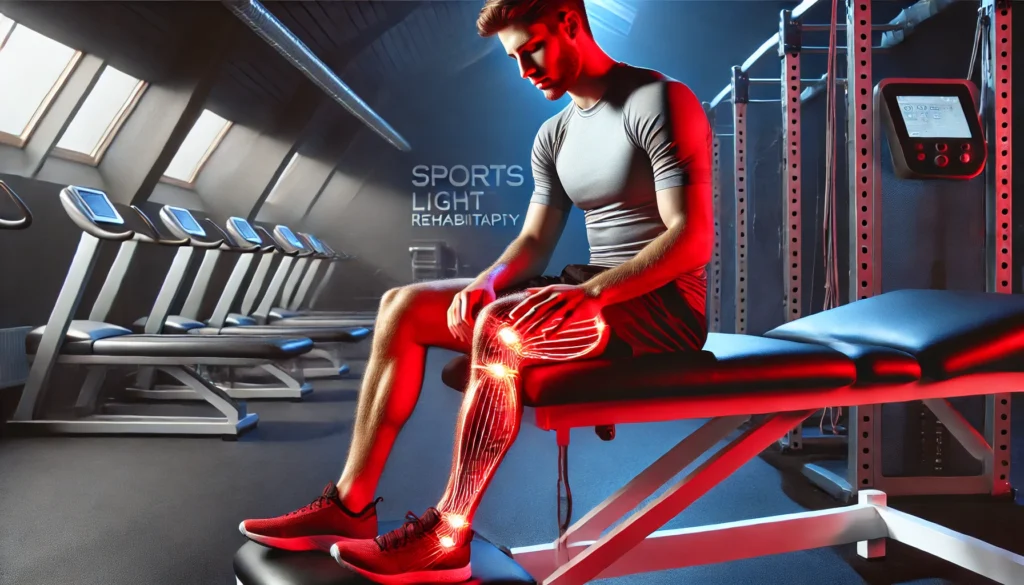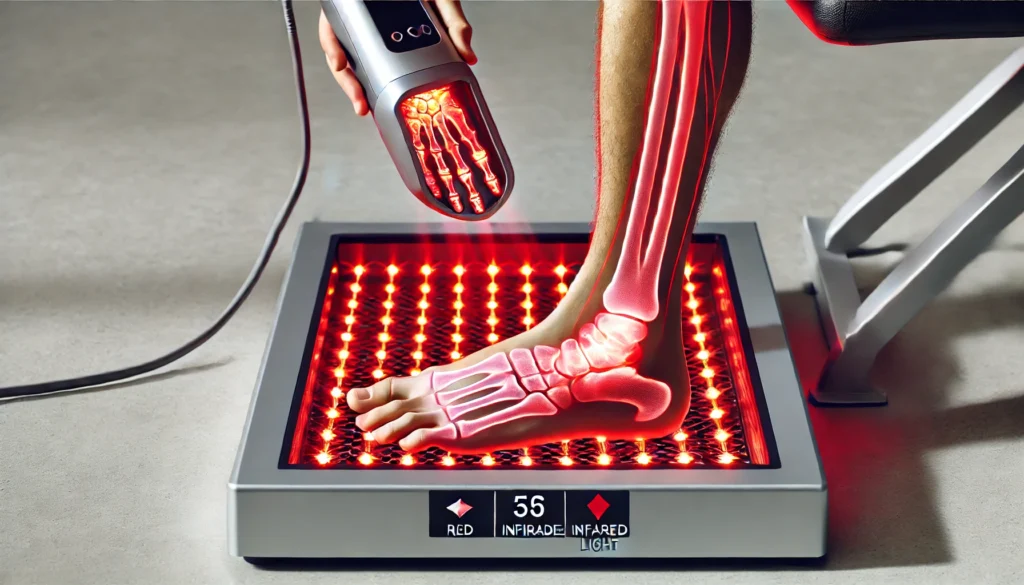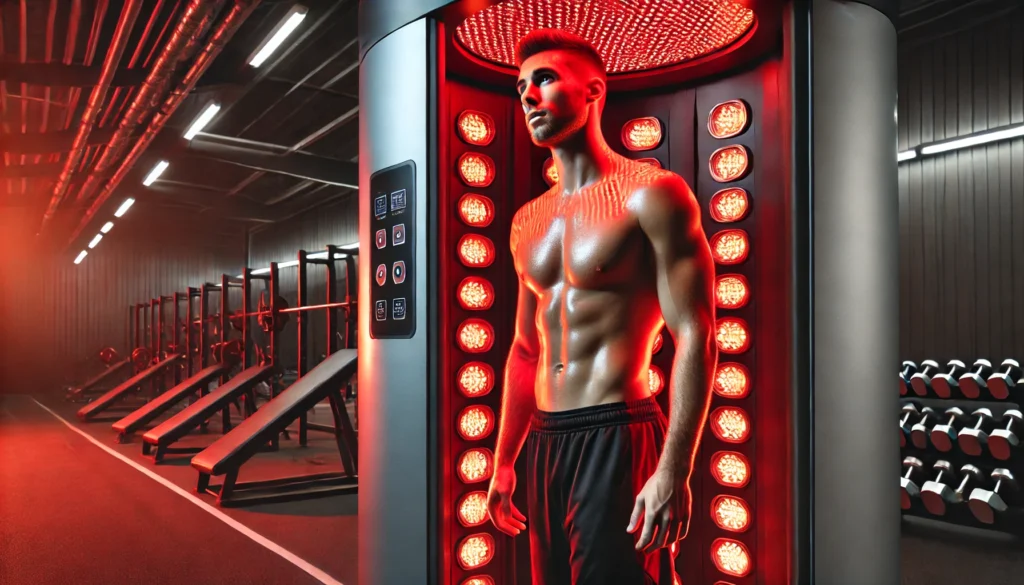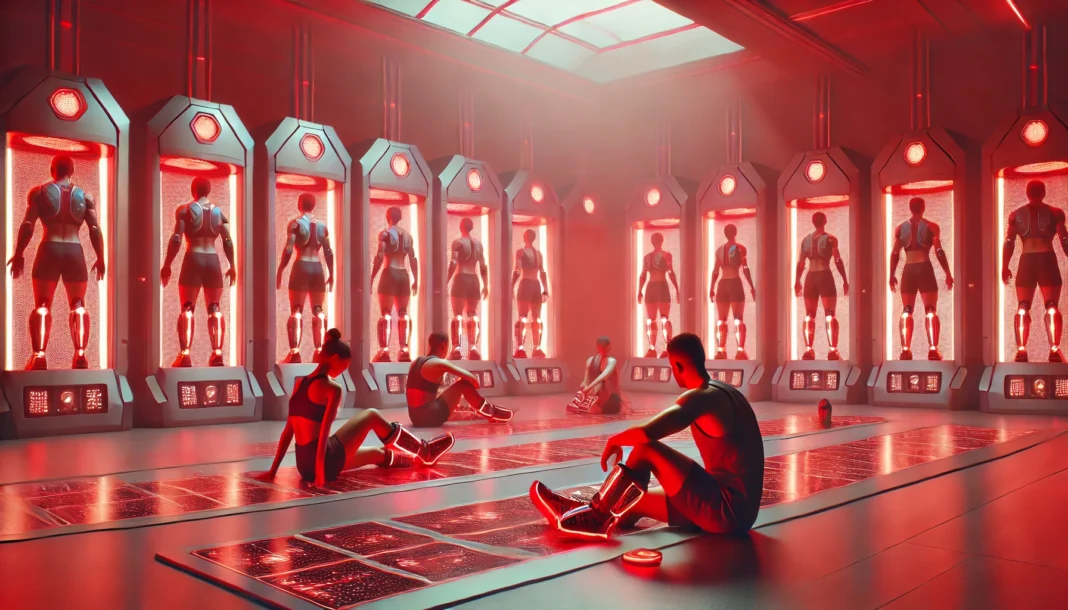Introduction: The Intersection of Red Light Therapy and Athletic Recovery
Athletes push their bodies to the limit, and recovery is essential for sustained peak performance. One of the most promising advancements in sports medicine is the use of red light therapy for nerve pain and muscle regeneration. Neuropathy, a condition that affects the nerves, can hinder an athlete’s ability to train and compete. As science delves deeper into innovative recovery techniques, red light therapy has emerged as a non-invasive, scientifically backed solution that enhances nerve function and accelerates healing. But does red light therapy help neuropathy? The growing body of research and athlete testimonials suggest it does. In this article, we will explore the mechanisms behind red light therapy, its benefits for neuropathy, and how it can be optimized for athletic recovery.
You may also like: Red Light Therapy for Muscle Recovery: How Athletes Can Speed Healing and Enhance Performance
Understanding Neuropathy and Its Impact on Athletes
Neuropathy, often associated with diabetes and chronic conditions, also affects athletes due to repetitive stress, nerve compression, and sports-related injuries. Peripheral neuropathy, in particular, results in numbness, tingling, and pain in the extremities, including the feet. Given the physical demands of athletic performance, neuropathy can drastically reduce mobility, balance, and overall function, making recovery a top priority.
For athletes, foot neuropathy can be particularly debilitating, affecting gait, endurance, and stability. The best red light therapy for foot neuropathy addresses these challenges by stimulating nerve repair, increasing circulation, and reducing inflammation. Athletes looking for an effective, drug-free approach to recovery are increasingly turning to red light therapy to regain optimal function and extend their careers.
How Red Light Therapy Works: A Scientific Overview
Red light therapy operates on the principle of photobiomodulation, a process in which red and near-infrared light penetrate the skin to reach cellular structures like the mitochondria. Mitochondria, often referred to as the powerhouse of the cell, play a crucial role in energy production. When exposed to specific wavelengths of red light, mitochondria produce more adenosine triphosphate (ATP), the energy currency of cells. This increase in ATP production facilitates faster cellular repair, reduces oxidative stress, and enhances circulation.
The best red light therapy for neuropathy employs wavelengths between 600 and 850 nanometers (nm), which have been shown to penetrate deep into tissues. These wavelengths improve blood flow, increase the production of anti-inflammatory cytokines, and promote nerve regeneration. For athletes, the ability of red light therapy to accelerate tissue healing, alleviate nerve pain, and enhance recovery times is invaluable.
Red Light Therapy for Feet: A Game-Changer for Athletes
Foot health is critical for athletic performance. Whether running, jumping, or pivoting, the feet bear the brunt of an athlete’s movements. Red light therapy for feet offers a non-invasive solution to common issues such as plantar fasciitis, Achilles tendonitis, and neuropathic pain.
Studies have demonstrated that red light therapy can improve circulation in the feet, which is crucial for nerve regeneration and pain relief. By increasing nitric oxide production, red light therapy enhances vasodilation, allowing oxygen and nutrients to reach damaged nerves and tissues more efficiently. Athletes who incorporate red light therapy into their recovery routines report reduced pain, increased flexibility, and improved foot function.
The Best Red Light Therapy for Neuropathy: Selecting the Right Device
Choosing the best red light therapy for neuropathy involves understanding key factors such as wavelength, intensity, and treatment duration. Not all red light therapy devices are created equal, and athletes must select a device that meets their specific recovery needs.
High-quality red light therapy devices for neuropathy should offer wavelengths within the 600-850 nm range, adjustable intensity levels, and FDA approval for safety and efficacy. Additionally, the best red light therapy for neuropathy reviews often highlight devices with customizable settings, allowing athletes to tailor their treatment based on the severity of their symptoms.
Portable red light therapy devices have become increasingly popular among athletes, providing the flexibility to incorporate treatments into travel and training schedules. Many high-performing athletes use red light therapy panels, boots, and handheld devices to target specific areas affected by nerve pain.

Red Light Therapy for Nerve Pain: Mechanisms and Benefits
Nerve pain, or neuropathic pain, is often challenging to treat with conventional methods. Red light therapy for nerve pain works by reducing inflammation, increasing endorphin production, and promoting myelin repair—the protective sheath around nerves.
Athletes suffering from nerve pain due to overuse injuries, trauma, or surgical recovery find significant relief with red light therapy. Unlike medications that mask pain, red light therapy addresses the root cause by enhancing nerve function and accelerating tissue healing. Regular use can lead to long-term improvements in pain management, reducing reliance on painkillers and anti-inflammatory drugs.
Practical Applications: Integrating Red Light Therapy into Athletic Recovery
Incorporating red light therapy into an athlete’s recovery routine involves consistency and proper usage. Treatments typically last between 10-20 minutes per session, depending on the device and area being treated. Most athletes benefit from using red light therapy at least three to five times per week.
For optimal results, athletes should apply red light therapy post-training to reduce inflammation and expedite recovery. Using red light therapy before workouts can also improve circulation, warming up muscles and preventing injuries. Additionally, combining red light therapy with complementary recovery strategies such as cryotherapy, massage, and stretching enhances its effectiveness.
Frequently Asked Questions: Red Light Therapy for Neuropathy and Athletic Recovery
1. How does red light therapy compare to other neuropathy treatments? Red light therapy stands out from other neuropathy treatments because it is non-invasive and does not rely on medication. Traditional approaches, such as painkillers and anti-inflammatory drugs, often mask symptoms rather than addressing the root cause. In contrast, the best red light therapy for neuropathy works at a cellular level, promoting nerve regeneration and reducing inflammation. Unlike physical therapy, which requires consistent effort and movement, red light therapy allows athletes to recover passively while still experiencing significant benefits. When combined with a comprehensive recovery plan, including exercise, proper nutrition, and rest, red light therapy enhances overall healing and long-term nerve health.
2. What makes the best red light therapy for foot neuropathy different from general red light therapy? Foot neuropathy presents unique challenges due to the complexity of the foot’s nerve network and the constant stress placed on this area. The best red light therapy for foot neuropathy is designed with targeted wavelengths that penetrate deeply into the foot’s tissues to stimulate nerve repair. Devices created specifically for feet often incorporate wrap-around designs or foot pads to ensure even exposure to red and near-infrared light. This localized approach differs from full-body panels, which may not provide the concentrated intensity needed for neuropathy relief in the feet. As athletes rely heavily on foot function, specialized red light therapy devices help maintain optimal performance and prevent long-term nerve damage.
3. What do red light therapy for neuropathy reviews typically highlight as the biggest benefits? Reviews of red light therapy for neuropathy frequently highlight reduced pain, improved sensation, and faster recovery times as key benefits. Many users report feeling significant relief within a few weeks of consistent use, particularly in cases of foot neuropathy. Athletes appreciate the therapy’s ability to restore mobility and decrease discomfort after intense training sessions. Reviews also emphasize the therapy’s non-invasive nature, making it an appealing alternative to pharmaceutical treatments with potential side effects. Additionally, long-term users often note increased circulation in affected areas, leading to healthier nerve function over time.
4. Does red light therapy help neuropathy caused by sports injuries? Yes, red light therapy has shown great promise in addressing neuropathy caused by sports injuries. Repetitive motion, impact trauma, and nerve compression can contribute to nerve pain and dysfunction in athletes. Red light therapy for nerve pain stimulates the repair of damaged nerve cells, reducing the lingering effects of sports-related injuries. It also helps decrease inflammation, which is a common cause of nerve compression and discomfort in highly active individuals. By integrating red light therapy into an athlete’s recovery routine, they can mitigate nerve damage and prevent long-term complications that could impact their performance.

5. Can red light therapy for feet improve athletic performance beyond recovery? Beyond recovery, red light therapy for feet has the potential to enhance overall athletic performance by improving circulation and reducing muscle fatigue. Increased blood flow ensures that muscles and nerves receive sufficient oxygen and nutrients, leading to better endurance and reduced risk of cramps. Additionally, red light therapy helps prevent foot-related conditions such as plantar fasciitis and Achilles tendonitis, which can sideline athletes. By maintaining foot health, athletes can train more consistently and with greater intensity. Over time, regular use of red light therapy contributes to stronger, more resilient feet, supporting peak physical performance.
6. How frequently should athletes use red light therapy for nerve pain? The optimal frequency for using red light therapy depends on the severity of the nerve pain and the athlete’s recovery needs. Most experts recommend using red light therapy three to five times per week for optimal results. For acute nerve pain or injury recovery, daily treatments may be beneficial in the initial stages. Once improvements are noticeable, reducing sessions to a few times a week can help maintain nerve health. Consistency is key, as sporadic treatments may not provide sustained benefits. Athletes should also consider combining red light therapy with stretching, hydration, and proper nutrition for comprehensive recovery.
7. Can red light therapy be used alongside other treatments for neuropathy? Yes, red light therapy can be safely combined with other neuropathy treatments for enhanced results. Many athletes pair red light therapy with physical therapy, massage, and electrical stimulation to create a multifaceted recovery plan. Additionally, dietary interventions that support nerve health, such as increasing B vitamins and omega-3 fatty acids, complement the benefits of red light therapy. Some individuals also find acupuncture beneficial when used alongside red light therapy. Because red light therapy has no known negative interactions with other treatments, it is an excellent addition to a well-rounded recovery regimen.
8. Are there any risks or side effects associated with red light therapy for neuropathy? Red light therapy is considered a safe and well-tolerated treatment with minimal risks. Unlike medications or invasive procedures, it does not produce harmful side effects when used appropriately. However, excessive exposure beyond recommended guidelines may lead to temporary skin irritation or mild discomfort. Athletes should follow manufacturer guidelines to avoid overuse and ensure they are using a high-quality device with proper wavelength settings. As with any treatment, individuals with underlying medical conditions should consult a healthcare professional before starting red light therapy for neuropathy.
9. How long does it take to see results from the best red light therapy for neuropathy? The time required to see results varies based on the severity of the neuropathy and the consistency of treatments. Some individuals report noticeable improvements in nerve pain and function within two to four weeks. However, more severe cases may require several months of consistent use before substantial progress is observed. Athletes with mild nerve discomfort may experience faster recovery times compared to those with chronic neuropathy. The key to success is patience and adherence to a regular treatment schedule, as red light therapy works gradually to regenerate nerves and enhance circulation.
10. What should athletes look for when choosing the best red light therapy for neuropathy? Athletes should consider several factors when selecting a red light therapy device for neuropathy. First, the device should offer wavelengths between 600-850 nanometers, as this range is most effective for nerve repair. Intensity and treatment area coverage are also important, with higher-quality devices providing better penetration and targeted exposure. Portability and ease of use matter for athletes who travel frequently and need to maintain their recovery routine. Lastly, looking at red light therapy for neuropathy reviews can provide insight into real-world effectiveness and user satisfaction. Choosing an FDA-cleared or clinically tested device ensures safety and optimal performance.

Conclusion: The Future of Red Light Therapy in Athletic Performance
As research continues to validate the benefits of red light therapy for neuropathy, its role in athletic recovery is set to expand. Athletes looking for cutting-edge recovery methods are embracing red light therapy for its ability to accelerate healing, reduce pain, and enhance performance longevity. By integrating this technology into their training regimens, athletes can maximize their potential while minimizing the risks associated with nerve pain and injury.
The best red light therapy for foot neuropathy, as well as broader neuropathic conditions, offers a non-invasive, scientifically backed approach to sports recovery. As more elite athletes and trainers incorporate this technology, it is poised to become a cornerstone of performance enhancement and rehabilitation in the years to come.
red light therapy, neuropathy treatment, athletic recovery, sports performance, nerve pain relief, best red light therapy for foot neuropathy, best red light therapy for neuropathy, red light therapy for feet, red light therapy for neuropathy reviews, red light therapy for nerve pain, does red light therapy help neuropathy, sports injury recovery, photobiomodulation, nerve regeneration, muscle recovery, circulation improvement, non-invasive therapy, foot health, sports rehabilitation, athlete wellness
Further Reading:
Red Light Therapy For Neurological Conditions Explained
5 Ways Neurocare Light Therapy and Physical Therapy Combine for Peripheral Neuropathy Relief
How Red Light Therapy Can Aid in Nerve Damage Recovery
Disclaimer
The information contained in this article is provided for general informational purposes only and is not intended to serve as medical, legal, or professional advice. While NewsHealthWatch strives to present accurate, up-to-date, and reliable content, no warranty or guarantee, expressed or implied, is made regarding the completeness, accuracy, or adequacy of the information provided. Readers are strongly advised to seek the guidance of a qualified healthcare provider or other relevant professionals before acting on any information contained in this article. NewsHealthWatch, its authors, editors, and contributors expressly disclaim any liability for any damages, losses, or consequences arising directly or indirectly from the use, interpretation, or reliance on any information presented herein. The views and opinions expressed in this article are those of the author(s) and do not necessarily reflect the official policies or positions of NewsHealthWatch.

